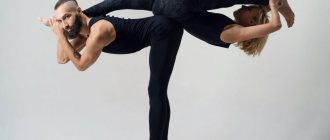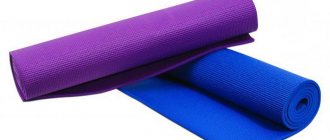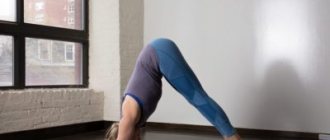Sports and psychology are very closely related. Angry at the whole world? Try some yoga poses to calm yourself down. Without a doubt, the benefits of these exercises are enormous. Yoga helps to cope with a variety of problems related to mental or physical health.
If you're not having the best day and need to let off some steam, yoga can help you calm down. Practicing the right poses can help reduce stress and tension and ease tension in your body. These few yoga asanas will help you stay calm and control your anger even when the situation threatens to get out of control.
Reclining goddess
This asana is calming and also helps to relax some of the muscles in the body. If you are using this as a restorative pose, your position should be as comfortable as possible and your body should have sufficient support. The goal of the exercise is to maintain this position while gravity improves your stretch while you clear your mind. You can use it any time of the day. It relaxes and calms the mind. A group of muscles called the hip flexors become tight when you spend a lot of time sitting. Stretching them in this case can help relieve and prevent lower back pain.
A broken nail is no problem: tips for treating nails at home
Seven daily habits of happy people
Sometimes we wear a bra incorrectly: ways that are harmful to health
Almost anyone can do this asana as it is simple. Sit on the floor and grab a medium-height block to place under your shoulder blades. Take another block to use as a pillow. Now let your body rest freely on the blocks. Then make sure your knees are apart and your feet are together. Maintain this pose while you take 10 deep breaths, then calmly come out of this position.
Yoga poses are not neutral. All classical asanas have spiritual meaning
Hidden Flame: An Orthodox View of Yoga
I am a Catholic by birth. I loved to pray. Walks in the forest, games on the river, wanderings through the vast expanses of imagination. All this was a form of prayer for me: silence, peace, almost hesychia, so natural for a child. I was not constantly in this state of prayer. But I recognized him. This experience was given to me for free, simply as an action in my heart.
We all, to varying degrees, experience this. Some names are given to this - or not given at all, because all the words seem so unsuitable for expressing the movement of the heart towards God. When we are innocent at heart, especially in early youth, there is an experience of two in this experience. Loving and Beloved. Somebody else. As a child, I could not clearly identify this Presence of Christ, just as I never called my parents by name. I just knew them.
***
When I was in high school—my grandparents sent me to an all-boys Catholic school—I wanted to become a Trappist monk. I attended services regularly and read the Bible often. Scripture is truly like a door. You can walk through it and the Holy Spirit will take you to different places without ever leaving your soles off the ground. But I knew there was something more. That there is a difference between reading about events and experiencing an encounter with Him.
Dr. Harry Bouzalis writes in Sacred Tradition: “We are not called to simply “follow” the Tradition or “imitate” the Tradition. We are called to experience it... as the saints did and continue to do now.” We know that something is missing in the world around us. A certain wealth, a certain depth that we intuitively know about and strive for. This, of course, is the wealth of God's love, light and grace. But at that time in my life, I didn't have the words to express it. Like many, I associated this dissatisfaction, this anxiety with other things.
A psychology professor introduced us to self-hypnosis. This is how my affair with meditation began.
In high school, a psychology professor introduced us to self-hypnosis. And soon my affair with meditation began. I relaxed. I threw caution to the wind for a new experience. I felt as if the back door of my soul was constantly open. I rejected God “to be on my own.” I experienced - very clearly - how the light went out inside me. The Presence, the Someone, the Friend respected my decision. It felt like He had quietly left. He respects free will. He never imposes Himself. He knocks on the door of the heart and waits.
* * *
I didn’t know then that Tibetan Buddhism comes from the shamanic religion Bon
I started meditating regularly. At first, as a teenager, it was very difficult for me to sit for hours with old Tibetan monks, completely motionless, turning all my thoughts to the bare wall and the bronze statue of Buddha in front of me. I delved into the teachings of reincarnation, karma and samsara[1]. I did not know then that Tibetan Buddhism comes from the shamanic religion of Bon and that it includes astrology, witchcraft and other occult practices.
I wanted to know how to overcome anxiety and depression, how to collect my scattered thoughts. Visiting Buddhist meditation halls and Hindu ashrams, I was intrigued by the “spiritual fireworks”: ecstasy, trance, feelings and visions. All this is associated with various levels of meditation and yoga and multiplies with practice. These and other experiences are sometimes given by siddhis or powers accumulated through sadhana (the practice of meditation and yoga). The affair grew into infatuation, infatuation became a habit. And I didn’t notice how my initial “harmless” interest in yoga and meditation solidified into attachment. I plunged into this spiritual abyss for more than ten years.
And all these years I asked different questions. For example, what do Catholic priests and monks know about whether the early Christians believed in the pre-existence of souls and reincarnation? They replied that they knew nothing about it. And in addition they asked: what is this anyway? Immersing myself more and more in the sources and concepts of Eastern religions, passionately wanting to penetrate the bardo - the intermediate dimension between the spiritual and material worlds - I began to study the “Tibetan Book of the Dead”.
I studied all the mystical and esoteric literature that came into my hands, always carried a volume of the Bhagavad Gita in my back pocket and read the works of Paramahansa Yogananda. I immersed myself in reading Osho, Ram Dass and Ramana Maharshi, convinced that there was no being more divine than myself. But my illusory self was destroyed by myself. According to many books I had read and what I had heard, there could not be a personal relationship with the Divine, and this created conflicts in my soul. The peace and quiet of childhood is gone. The deeper I went into meditation and yoga, the more often sudden, unexpected thoughts came that brought me pain. My soul was amazed. It was a very dark and sad period of my life.
In search of peace, I took the bodhisattva vow and joined a contemplative and peaceful Buddhist monastic order, trying to somehow gain a foothold somewhere. After an initial period of relative peace, audacity, even recklessness, and restless spiritual movements appeared. It was something like spiritual alcoholism. But I didn’t suspect it then.
* * *
The prodigal son ate the food of pigs in a distant land. But he returned home when he remembered the taste of bread in the Father's house. For more than ten years I lived in this distant country and ate its food.
I have seen so many people, both friends and strangers, seeking to dissolve themselves. They had an insatiable desire to lose themselves, but not in the life and light of God, but in the darkness of emptiness, separating themselves from the Love that surpasses everything. This department is hell. Many men, women and children seek this hell, rolling through promiscuous relationships and jumping out of drug windows through which so many have fallen.
I studied and practiced kundalini yoga and shamanism, learned the presence of fear and cold.
I have gained a reputation as a tarot card reader. I have taught yoga and been an instructor in guided meditation and chanting groups in deep deserts. We experimented with astral projection, a guided out-of-body experience through the bardo described in Tibetan books. I carried with me everywhere not only the Bhagavad Gita, but also the Upanishads and Buddhist sutras. All these activities took me further and further away from the holy mountain of Christ. Drop by drop, the stone wears away. With my forehead smeared with orange paste, I rang the bell, bringing fruit and lighting a fire in worship of Krishna, wandering barefoot through the streets of Eugene, Seattle, Portland, and then Rishikesh, Haridwar and Dharamsala in northern India.
* * *
Archimandrite Zacharias
“Separated from God, the Source of life,” writes Archimandrite Zacharias in the book “The Hidden Man of the Heart,” “a person can withdraw only into himself... Gradually he becomes empty and corrupted.”
In Buddhism, God, soul, personality is an illusion that must be overcome, discarded, destroyed
Buddhism rejects individuality, soul and personality. Folds his hands in silence against God. Suffering is not transformed there. In Buddhism there are crosses, but resurrection is not possible. One could say that Buddhism finds the empty tomb and declares its emptiness as the natural state of things, even the purpose of existence. In Buddhism, everything: heaven, hell, God, the individual, the soul, the personality - is an illusion that must be overcome, discarded, destroyed. That's the goal. Complete destruction. In a 9th century saying, the essence of Buddhism is expressed as follows: “If you see Buddha, kill him.”
Buddhism does not claim - and is not capable of - healing the soul and body. Soul and body must be overcome and abandoned. In the Orthodox Church, on the contrary, the soul and body receive healing. Buddhism teaches that nothing has intrinsic value. The Church teaches that everything created by God has intrinsic value. Including the human body. We are complex beings. The actions of our body, mind and soul are coordinated. And these coordinated actions directly depend on our communication with God and the spiritual sphere.
For Orthodox Christians, everything - even suffering - is a secret door through which we meet Christ and through this we embrace each other.
* * *
One autumn day I came to Rishikesh in India. This city is named after the pagan god Vishnu, the “god of feelings.” Rishikesh is the “Yoga Capital of the World”. It is generally accepted that this is the place where yoga originates. For 40 days I studied and practiced the so-called “secret path” of integral yoga in the foothills of the Himalayas. It included not only gymnastics, as in America, but each lesson began and ended with a prayer to the “god of the roaring storm” Shiva.
Yoga has historical roots in Hinduism
At that time, I was teaching English to Tibetan refugees and working for the Tibetan Government in Exile as an editor. Yoga has historical roots in Hinduism. Interestingly, while talking to a Rinpoche[2] at the Dalai Lama's monastery in Dharamsala, I asked who or what these Hindu gods are according to Buddhist cosmology. His answer was chilling: “They are created beings with an ego... They are spirits held in the air.”
What is yoga? What is kundalini energy?
The literal meaning of the word “yoga” is “bond, connection.” This means binding your will to the kundalini serpent and raising it to Shiva
Awakening kundalini energy
The literal meaning of the word “yoga” is “bond, connection.” This means connecting your will with the kundalini serpent[3] and raising it to Shiva, knowing your “true” essence. All areas of yoga are interconnected, like the branches of a tree. Trees with roots descending to the same areas of the spiritual world. This is reflected in the ancient books of Bhagavad Gita and Yoga Sutras of Patanjali. I learned that the ultimate goal of yoga is to awaken the kundalini energy coiled at the base of the spine in the form of a serpent, and this will lead to a state that allows one to realize Tat Tvam Asi[4].
Of course, yoga can initiate unusual states of mind and body. But the same thing can be achieved with the help of psychotropic drugs and tasteless, invisible poisons. Through yoga one gradually becomes familiar with shakti, whom yogis refer to as the “divine mother,” the “dark goddess,” associated with other major Hindu deities. This energy is not from the Holy Spirit, and it is not just aerobics or gymnastics. Attached to this entire system are bhayans and kirtans - the pagan equivalents of Orthodox Christian akathists, and to the Hindu gods - also mantras, which are “sacred” formulas, like telephone cards or telephone numbers of various pagan gurus and gods.
How is yoga related to Hinduism?
To be honest, Hinduism is not a single religion. This is the term used by the British to describe various cults, schools of thought and shamanic religions in India. If you ask a Hindu if he believes in God, he will probably say that you yourself are God. But ask another and he will point out a rock, or a statue, or a flame of fire. This is the Hindu polarity: either you yourself are God, or everything around you is God.
Yoga functions as a missionary arm of Hinduism outside India
Yoga comes under the umbrella of Hinduism and for many reasons is the tip of that umbrella. It functions as a missionary arm of Hinduism and the New Age outside India. Hinduism is like a nesting doll: you discover one philosophy and it contains ten thousand others.
And undiscovered ones carry risks. You can swim easily and carefree in unknown waters. But if you don't know about the tides and the characteristics of the area, you can get into trouble. You could be carried away by an undercurrent. You can get hurt on invisible rocks, or catch an unknown infection, or get poisoned.
This happens in spiritual life too.
When we dive in the ocean, we may be attracted to colorful, colorful or interesting fish, but the most colorful and exotic are the most poisonous and deadly.
When I first came to India, I took off my shoes and socks and walked through spilled water, coconuts, scattered sweets and the twinkling lights of the Kalkaji Temple. This is one of the most famous temples dedicated to Kali, the “goddess of death”. I didn’t know that I was in the middle of a crowd celebrating its most important holiday. The temple was in chaos and tensions reached a dark climax.
The woman next to me had her eyes rolled back in her head, her arms were moving back and forth, her tongue was hanging out of her mouth, her legs were jerking up and down like a puppet.
Thousands of men, women and children gathered in that Rishikesh temple to worship this demon. The woman next to me had her eyes rolled back in her head, her arms moving back and forth, her tongue hanging out of her mouth, her legs jerking up and down like a puppet. It was obvious demonic possession.
One day I venerated the Sitka Icon of the Mother of God and experienced indescribable warmth, tears of humility and love, clarity of mind and peace. It was as if I had walked past a window full of warm, fragrant sunlight. At Kalkaji Temple I experienced the opposite.
Kali is often depicted as a fearsome, blue-skinned, many-armed goddess standing on top of human heads with a bloody tongue hanging from her mouth. She is wearing a necklace made of human heads and a belt made of hands.
Yoga poses are not neutral. All classical asanas have spiritual meaning
I had coffee with people who were active in the yoga, Hinduism and New Age movements in America, who ate the meat of corpses from Nepalese cemeteries to initiate into the cult of this goddess. Not long ago, the popular British newspaper The Guardian wrote that a child was sacrificed in honor of the demon Kali. All this is typical of Hinduism. And this is all connected with yoga, because yoga poses are not neutral. All classical asanas have a spiritual meaning. For example, as one journalist writes, the Sun Salutation—perhaps the best-known sequence of asanas, or postures, of Hatha Yoga, especially popular and widespread in America—is actually a Hindu ritual.
“Sun salutations have never been a tradition of hatha yoga,” writes Subhas Rampersaud Tiwari, professor of yoga philosophy and meditation at the American Hindu University in Orlando, Florida. “This is a full circle of ritual veneration of the sun, gratitude for the source of energy.”
Thinking of yoga as just a physical exercise movement is tantamount to “saying that baptism is just an underwater exercise,” writes Swami Param, a spokesman for the Academy of Classical Hindu Yoga and Dharma Yoga Ashram in Manahawkin, New Jersey. .
It is Goddess Kali who seeks to unite practitioners through shakti with Shiva through yoga. In her temple, near New Delhi, I saw a disgusting self-explanatory idol: a stone with strange beaded eyes and a beak, covered with a yellowish, nasty and lumpy edible substance.
In Hinduism, idols are "awakened". They are dressed. They are fed. They sing to them. And then they are put to bed. I have taken part in these ceremonies hundreds of times.
The Yoga Journal has over 5 million subscribers and is the best-selling yoga magazine in the world. It is significant what the Yoga Journal wrote when, proving the superiority of yoga as psychotherapy, it speaks of the Hindu philosophy hidden behind the practices of yoga:
“In the yoga perspective, all human beings are “born divine,” and each person has at his core a soul (atman) that eternally resides in the unchanging, infinite, all-pervading reality (brahman). In Patanjali's classic formulation of this view...we are already what we strive for. We are the deity in hidden form. We are already, in essence, perfect, and our potential is ready at any moment to awaken to this truth, with an awakened consciousness and an enlightened nature.”[5].
Yoga teachers and students usually greet each other with the Sanskrit word “namaste,” which means, “I honor the divine in you.” This is an affirmation of pantheism and a betrayal of the true God revealed in the Bible. Sun salutation, or surya namaskara, comes from the veneration of the Hindu solar deity Surya.
In church hagiography and iconography, we honor saints - real people who lived righteously before God, who have joined and continue to join His light and love - and ask for their intercession. Idols, as Father Mikhail Pomazansky writes, are “images of false gods, and the worship of them is the worship of demons or imaginary creatures that have no existence; and thus, in essence, it is the worship of lifeless objects.”
I have seen swamis in America - those who transmit this demonic kundalini energy simply by looking into a person's eyes. And if he is open to it, his body can shake and vibrate like a wind-up iron toy.
And when the time came for me to accept this damned energy through Shaktipat [6], incredible fear gripped me like icy, electrified water, and I raised my shield and sword: I began to say the Jesus Prayer. God bless! This eerie presence was reflected in the name of Jesus. We must remember that, as the Apostle Paul writes, “we wrestle not against flesh and blood, but against the rulers, against the powers, against the rulers of the darkness of this world, against spiritual wickedness in high places” (Eph. 6:12).
With this prayer, as with a shield and sword, I swam back to Christ. I came from a distant country. I took a step towards my Father's House.
Yoga and Orthodoxy
Yoga is a psychosomatic practice, the interaction between mind, body and spirit(s). We must remember that the word "yoga" means "yoke" - a wooden cross placed on the neck of animals and attached to the plough. Remember that the Apostle Paul warns us: “Do not be unequally yoked with unbelievers, for what fellowship has righteousness with iniquity? What does light have in common with darkness?
Yoga does not belong to Scripture and is not part of the Sacred Tradition of our Church. Everything we need is found through the Orthodox Church. So what do we want from yoga?
It is important to know that in yoga, as in many mystical schools, strange lights may appear to practitioners, but most likely they are from demons or created lights in the mind, because “Satan himself takes the form of an angel of light” (2 Cor. 11: 14 ). Many have encountered and followed the “spiritual fireworks” of the so-called “new” century. Of course, this is not the Uncreated Light that Moses and the disciples saw on Mount Tabor. This is not the Divine Light that defended St. Gregory Palamas in the 14th century from Western scholastics. Direct knowledge of God is possible, as is direct experience of His knowledge, but knowledge and experience of evil are also certainly available. We have free will to choose who and what we seek. This, of course, requires prudence and testing, where the presentation of what has been tested before an experienced confessor is a necessary condition. Without a doubt, heartfelt participation in the Sacraments of the Church is necessary. It is better for us to look at the mysteries in our hearts than to be entertained by the imagination of our minds.
Popular forms of gymnastic yoga are dangerous and can harm the practitioner
It is also necessary to say a few words about the statement that popular forms of gymnastic yoga do not pose harm or danger to the practitioner. Those who hold this opinion are either not sufficiently informed or deliberately ignore many of the warnings found in Eastern yoga manuals regarding Hatha Yoga for practitioners. Is the instructor aware of these warnings and can ensure that the student will not be harmed?
In his book The Seven Schools of Yoga, Ernest Wood prefaces his description of Hatha Yoga with these words: “I must address some Hatha Yoga practitioners with a stern warning. Many people got incurable diseases and even went crazy because they did yoga exercises without bringing their soul and body into proper condition. Books on yoga are full of such warnings... For example, the Geranda Samhita declares that if one begins to practice in hot, cold or rainy weather, it will lead to illness; also if there is no moderation in food and the stomach is more than half full of heavy food... “Hatha Yoga Pradipika” says that breathing control must be established gradually, “like lions, elephants and tigers are tamed,” otherwise “the experimenter will be killed”; and with any mistakes, cough, asthma, headaches, pain in the eyes and ears and many other diseases arise.” Wood concludes his warnings about the poses and breathing by saying, “I must make it clear that I do not recommend these exercises because I believe that hatha yoga is very dangerous.”
You cannot try to improve the life of the body at the expense of the soul.
If an Orthodox Christian wants to exercise physically, then he can swim, run, walk or do gymnastic exercises, he can do aerobics, fitness. These are safe alternatives to yoga. We can also bow to the ground before God. The Church does not want to make us unhealthy or unhappy. We must trust the instructions of the Mother Church and follow them to the extent that we can and as the grace of God allows. You cannot try to improve the life of the body at the expense of the soul.
You should also not trust your own opinion. There must be leadership.
“Trust in the Lord with all your heart, and lean not on your own understanding” (Prov. 3:5).
As Orthodox Christians, we know that the actions of our body, such as bowing, prostrating, and making the sign of the cross, have an impact on the state of our soul before the True God. Why should we try to copy bodily actions that for many centuries were directly associated with the service of demons? Such actions have serious consequences for the soul and body that belong to Christ.
“Let us be wise as serpents and innocent as doves” (Matthew 10:16).
Joseph Magnus Frangipani
Translated from English by Vasily Tomachinsky
Hidden Fire: Orthodox Perspectives on Yoga
https://ruskline.ru/monitoring_…
[1] Reincarnation - in Eastern religions, the doctrine of the re-incarnation of the soul after the death of the body into another being; reincarnation. Karma - in Buddhism, Hinduism and other religions of the East, a set of actions committed by a person and their consequences, which determines the fate and nature of his new birth, reincarnation. Samsara (or samsara), “wandering, wandering” - the cycle of birth, life and death.
[2] Rinpoche is a recognized reborn and advanced teacher in Buddhism.
[3] Kundalini means “coiled,” “coiled in the shape of a snake.” In yoga and esotericism - the idea of energy concentrated at the base of the spine; There are various methods and practices whose goal is to “awaken the snake” by raising energy up the spine. The presence of the "awakened" kundalini energy, also called shakti, should lead to union with Shiva, the ancestor and god of yoga.
[4] “Thou Art” is one of the “great sayings” of the Upanishads. It was pronounced by the teacher Uddalaka Aruni while teaching his son Shvetaketu. They hint at the identity of the innermost essence of man with the “last foundation of the external world,” Atman and Brahman.
[5] Cote Stephen. Standing Psychotherapy on Its Head // Yoga Journal. 2001. May/June. P.104 // https://michaeltalbotkelly.com/standing-psychotherapy-on-its-head/
[6] Shaktipat (Sanskrit) - the transfer of power, the spiritual energy of kundalini from the teacher, in whom it is already active, to the student. Element of the rite of passage in Tantrism. Transmission can occur through a glance, touch, mental message, pronouncing a mantra, through things (fruit, flower, letter), on the phone or TV.
Ganesha mudra
You can perform this asana even in the office. Take a comfortable sitting position. Place your right hand in front of your left. Then rotate your hands so that your fingertips point to opposite elbows and your right palm faces your heart. Then press the fingers of your right hand tightly against the fingers of your left. Take a deep breath and stretch your elbows out to the sides, making sure that all your fingers are tightly clasped. Maintain the asana for five breaths. Then repeat, switching hands.
Benefits of asana:
- It lifts your spirits.
- Increases confidence.
- Relieves stress and tension.
Yoga is a wonderful practice that has a positive effect on our entire body and our health. It increases endurance, flexibility, strength and, in general, the ability to control your body and its individual parts. Enhances self-confidence and sensitivity. Improves breathing. And these are just some of the benefits. At the same time, it benefits both men and women.
I will describe several yoga asanas that have a particularly beneficial effect on a woman’s health.
To begin with, what are Asanas? The word “asana” from Sanskrit means “posture”, “position”. Asanas are certain static body positions that must be held for some time.
Asanas help bring the body into a balanced state. These are body positions in which the muscular system is toned, but at the same time the ability to relax the body and mind is acquired.
Asanas strengthen undeveloped muscles, develop joints and spine, and eliminate stiffness of ligaments and tendons. When performing asanas, a large number of muscles, ligaments and joints are involved simultaneously. Unlike conventional physical education, in addition to tension and relaxation of muscles, stretching, twisting and compression of muscles and tendons occurs.
Due to the duration of holding the asana, the functioning of the musculoskeletal system is optimized. Regular practice leads to improved functioning of the cardiovascular, nervous and endocrine systems.
You need to enter the asana slowly, consciously. The use of force is not acceptable. The pose must be maintained for a certain time.
- When entering the asana and holding the pose, it is necessary to control your breathing, which should be calm and deep. Consciousness is directed to internal sensations, without being distracted by the environment.
- You need to remain motionless in the asana for several minutes, while trying to relax as much as possible those muscles that are not involved in holding the asana.
The effect of asanas has a deep anatomical meaning. To understand why each asana is good, you need to clearly understand what it affects.
In this article I will tell you about asanas in a standing position.
Mountain Pose (Tadasana) is one of the fundamental yoga poses.
This is the main pose that forms good posture at any age. Particular attention must be paid to the distribution of body weight on both feet; when performing the asana, in no case should you transfer weight to one leg, or only to the heels, or only to the toes.
Performing this asana is very useful for those who have arthritis and poor mobility in the neck, shoulders, elbows, hands, stoop, back pain, numbness of the feet, flat feet, congestion in the calf muscles and thigh muscles, and also to avoid these troubles.
Technique:
Standing position, big toes together, distance between heels 2-3 fingers (so that the outer edges of the feet are parallel to each other). Transfer your weight to the centers of both feet so that you feel a close connection to the ground.
The calves are tense, the kneecaps are pulled up, the buttocks are inward. The abdomen is pulled in and upward towards the diaphragm. The chin is parallel to the floor. The facial muscles are relaxed.
The chest is open, the shoulders are lowered down, the shoulder blades are pressed to the body.
The palms are facing the hips, the fingers are together, but the hands are not tense. Do not press your hands to your hips; they are in a natural position.
Performing this asana:
- Strengthens the abdominal muscles, external and internal.
- Improves posture, ensures proper growth of vertebral bones.
- Helps release spinal nerves.
- Helps relieve constipation.
- Helps keep the spine, as well as the joints of the arms and legs young and flexible.
Goddess Pose (Utkata Konasana)
Every woman wants to feel like a goddess, and this asana will help you achieve this feeling.
This asana activates feminine energy and reveals a woman’s inner potential. Harmonizes and pacifies. Helps strengthen the muscles of the inner thigh, muscles of the perineum and pelvic floor. Relieves tension in the lower back. This pose can help relieve PMS and menopause and promote healthy functioning of the reproductive organs. Awakens sensitivity and sensuality, without which real, maddening intimacy with your loved one is impossible.
Technique:
Place your feet wider than shoulder-width apart.
Raise your arms and bend them at the elbows with your palms facing inward.
Turn your feet with your toes out 45 degrees.
As you exhale, squat down with your knees bent. Pull your hips forward and knees back.
Lower your shoulders and push your chest forward. Spread your arms out to the sides.
The gaze is directed forward, the chin is parallel to the floor.
This asana
- Opens the hip joints and straightens the chest.
- Well strengthens and tones the leg muscles.
- Stimulates the functioning of the genitourinary, respiratory and cardiovascular systems.
- Strengthens the spinal muscles.
Warrior Pose (Virabhadrasana)
This asana significantly strengthens the muscles of the legs, back and abdomen. It restores joint mobility, fat deposits in the waist and abdomen, strengthens the muscular system of the whole body, trains endurance and coordination. Opens the lungs, promotes their ventilation and removal of toxins.
The asana eliminates stiffness in the shoulders and back, tones the ankles and knees, cures stiffness in the neck, and the chest becomes elastic.
Technique:
Take the Mountain pose, exhale, spread your legs at a distance of 120-125 cm, turn your right foot to the right, your left foot 60 degrees to the right.
Push your feet onto the floor and bend your front knee.
Pull your tailbone down and your pubic bone up (This straightens your lower back and increases hip rotation at the hip joint).
Extend your arms to the sides. Crown up, then turn head to the right
Maintain the asana for 30 seconds (increase the duration over time).
The whole body should be in the same plane! The arms are tense as if they are being pulled in different directions.
Repeat everything on the other side.
Performing this asana
- Strengthens the muscles of the back, knees, hips, arms.
- Loosens the shoulder and hip joints.
- Opens the chest.
- Warms up the body.
- Prepares the body to perform more complex asanas.
- Gives a feeling of strength and confidence.
- Stabilization of thought processes, determination to achieve the goal.
Chair Pose (Utkatasana)
The asana eliminates stiffness in the shoulders and ankles, strengthens the ankles, thighs and calves, promotes uniform development of the leg muscles, stretches the shoulders, tones the abdominal organs, back and diaphragm, and massages the heart.
Technique:
Stand in Mountain Pose (feet together). Bend your knees and lower your buttocks down, as if sitting on a chair.
Point your tailbone down and your pubic bone up to fully straighten your lower back.
Stretch your arms above your head parallel to each other, lower yourself even lower, keeping your back as vertical as possible.
Remain in the lowest possible position for 10-30 seconds, gradually increasing the duration. Breathing is even and calm.
Performing this asana
- Eliminates shoulder stiffness.
- Promotes uniform development of leg muscles and even corrects minor leg defects.
- The diaphragm rises during the asana, slightly massaging the heart.
- The abdominal organs and back are toned, the chest opens.
Standing Forward Bend (Uttanasana)
The asana stretches the muscles of the hips and lower back, relaxes the spine. If you cannot bend forward completely without bending your legs, you can bend your knees slightly. At the same time, try to keep your stomach as close to your hips as possible.
Technique:
From Mountain Pose, big toes together, distance between heels 2-3 fingers. Raise your arms up to your sides, your hands are straight, all your fingers are together, not overextended. The arms are rigidly straightened at the elbows. The arms at the top continue the line of the crown, hands shoulder-width apart, palms facing each other. Bend forward slightly bending your knees so that your stomach rests on your hips, the abdominal wall is elastic, the ribs are separated from the hips. Place your hands in a lock, one hand outside, the other inside (at your discretion). Place the top of your head on your hands, release and relax the cervical vertebrae. Then we check the general relaxation of the remaining parts of the spine. Afterwards, we rigidly straighten our legs at the knees, the top of the head is pressed to our hands.
Benefits of asyna:
- Eliminates and prevents diseases of the abdominal organs.
- Improves digestion.
- Fights constipation.
- Helps with gases in the intestines.
- Eliminates excess fat deposits in the abdominal area.
- Makes the back more flexible, improves blood circulation and tones the spinal nerves.
- The pose calms the mind and relieves stress.
- Good stretch for the hamstrings.
- Eliminates symptoms of menopause.
- Blood supply to the brain increases.
- Depression is relieved and memory improves.
- The ankles are strengthened and their flexibility improves.
- The legs are strengthened, the shape and flexibility of the leg muscles are improved.
- The asana has a corrective effect on uterine displacement and menstrual irregularities.
- Bend forward while standing is beneficial during menopause.
- Provides great help with excess bile in the body, anemia, obesity, constipation.
- Relieves stomach pain.
- Improves the activity of the liver and spleen.
- Normalizes kidney activity.
- Reduces fatigue and anxiety.
- Relieves headaches and insomnia.
- Suitable for relieving symptoms of diseases such as asthma, sinusitis, infertility and osteoporosis.
This asana perfectly relaxes the back.
If you relax well, then after a while you will feel as if individual vertebrae, or rather, the ligaments between them, are stretching.
As a rule, after 10-20 minutes of such relaxation, the back feels just great, but under no circumstances rise from this pose abruptly; also do not do it if you have high blood pressure.
Yoga classes have a beneficial effect on our general condition. After training, you feel especially harmonious and full, and your body seems to start singing! Practice these simple yoga asanas and be happy.
With love.
More on the topic:
Club "MAGINYA"
SIMPLE AND SAFE YOGA
Subscribe to our newsletter
Warrior Pose (Variation III)
Stand in tadasana (mountain pose: legs together, back straight, arms at your sides and palms facing forward), exhale and bend forward. Inhale and as you exhale, step your left leg back into a lunge position. Your right knee should be at a right angle.
Only on a soft spot: Russian Domostroy forbade punishing children in any other way
From athletes to Hollywood stars: men Naomi Campbell
25 children of a childless man: an extraordinary reunion
Now, from a lunge position, extend your arms forward, at the same level parallel to the floor and with your palms facing each other. Synchronize the extension of your front leg with the lift of your back leg. Don't let your torso swing forward as you move into position.
Place your arms, torso and raised leg parallel to the floor. Raise your head slightly and look forward, but do not squeeze the back of your neck. Maintain this position for five to ten breaths.
Then, as you exhale, return to the lunge position. Place your hands on the floor on either side of your right leg and, exhaling, step your left foot forward, bringing it closer to your right foot. Stay in this inclined position for a few breaths, then do the same on the other side.
Standing poses
Sumo Wrestler Pose
This asana wonderfully trains the pelvic floor muscles, strengthens and gently stretches the perineal muscles, making them more elastic. Performed with mula bandha
(with retraction of the intimate muscles and anus) and with
uddiyana bandha
(with the abdominal muscles tightened while exhaling), helps to activate sexual energy and reproductive function; performed with twisting, improves digestion.
Description
1. Stand straight with your feet together. Tighten your stomach, straighten your shoulders and imagine that someone from above is pulling you up by an invisible thread tied to the top of your head. Inhale deeply and extend your arms out to the sides parallel to the ground.
2. As you exhale, take a wide step to the side and distribute your body weight evenly on both legs. Toes point outward, bring your pelvis forward as far as possible, pointing your tailbone exactly down in line with your heels. Breathe in.
3. As you exhale, slowly bend your knees, sitting down; try to keep your tailbone pointing straight down, in line with your heels. Keep your back straight.
4. If the asana seems difficult at first, place your hands on your knees, but do not lean on your hands. Rely on strong legs in this asana; knees bent at 90 degrees. Keep your back straight, remembering the “invisible thread” that pulls you by the crown. Later, you will be able to release your hands and place your palms at chest level. Maintain your balance as long as you can, then smoothly exit the asana.
Option 2
The same asana can be performed with Mula b a
ndhoy
(conscious contraction of the muscles of the vagina and anus).
So, take the Sumo Wrestler Pose
,
1. Exhale, relaxing the muscles of the perineum.
2. As you inhale, contract these muscles, imagining that you are pulling an object inside you. Hold this position while holding your inhalation.
3. As you exhale, release the tension in your intimate muscles, while maintaining the stillness of the posture (however, while holding mula bandha, breathing can be voluntary.
The main thing is to tense only the muscles of the perineum and pelvic floor, without helping yourself with facial expressions and gestures - the rest of the body should be relaxed).
Note.
In obstetrics and gynecology, yoga
Mula b
a ndha
is called the “Kegel exercise” and is recommended by many doctors as an indispensable practice for preparing for childbirth.
Option 3
Twisting in Sumo Wrestler pose. When turning to the right, the outflow of bile is activated; when twisting to the left, waste products continue their natural evacuation through the descending colon. In addition, twisting in this position continues to strengthen the pelvic floor muscles; the adrenal glands and thyroid gland are affected, and hormonal levels are stabilized.
1. Having taken the position as described above, twist: first to the right, then to the left. To do this, rest your palms on your knees; the legs are motionless.
2. Inhale, and as you exhale, turn your torso around its axis, trying to look behind your right shoulder. Straighten your left arm and pull your shoulder forward. Hold the position while breathing calmly.
3. Return to the starting position and, without standing up or straightening your legs, repeat the twist to the left.
The following series of simple asanas is also good for strengthening the pelvic floor muscles. From a cross-legged sitting pose ( Comfortable Pose or Sukkkh a
sana
), holding your palms opposite your chest in a prayer position ( Namast
e ), you need to slowly get up and sit down, maintaining balance. You need to keep your back straight and your legs crossed. Pull yourself up, imagining an invisible thread tied to the top of your head.
Hero Pose: Benefits
Virasana is useful for flat feet; when performing it, the ankles and feet are stretched, which has a beneficial effect on the formation of the arch of the foot. Of course, this may take months of practice.
The asana treats gout and rheumatic pain in the knees. It alleviates the condition of the deposition of salt spurs, and even helps to eliminate them, with regular exercise.
Virasana is one of the rare poses that can be done after eating: it can help get rid of the feeling of heaviness in the stomach.
Modifications and inventory
Place a blanket under the basin. If the quadriceps muscles in the front of your legs are too tight and you feel uncomfortable doing the pose, then roll up a blanket and place it on your shins in the first step (see instructions or photo above). When you sit on your buttocks, the blanket will soften the process of sitting in the pose.
Place a block under your pelvis. Alternatively, if your leg muscles are not particularly developed, place a block between your shins at the first point and sit on it. You can combine this modification with the option above.
Lean forward to stretch your butt muscles. To stretch the muscles of the buttocks and spine, gently lean forward at point 10 (above) so that your pelvis is firmly planted on the mat.
Place your fingers in Chin Mudra. The hands can be placed in one of several mudras (gestures) - instead of placing them on the mat in step seven, place your hands on your knees. When performing Chin Mudra, turn your palms up. Connect your thumb and index fingers. Extend your little, ring and middle fingers. This mudra is open to the world and energetic.
Place your fingers in Jnana Mudra. While performing Jnana Mudra (knowledge mudra), turn your palms down. Connect your thumb and index fingers. Place your little finger, ring and middle fingers on your knees. This mudra is closed to the world and is needed for immersion in reflection.
According to traditional yogic texts, the hands are the vehicles through which the body's energy - or prana - enters the world. The joining of the thumb and index finger in Chin Mudra or Jnana Mudra creates a chain of energy between the two fingers that interrupts the exchange of energy between the practitioner and the outside world. This helps meditation. Swami Satyananda Saraswati, for example, insists that no one should attempt to meditate without using one of these two mudras.
Related asanas
The hero asana is basic for various breathing practices, including the breathing technique of ujjayi pranayama and breathing of fire bhastrika pranayama. To practice Ujjayi breathing, first assume Hero Pose. Close your eyes and relax. Let your breathing become rhythmic. Imagine that you are breathing through your throat, inhaling and exhaling not through your nostrils, but through the back of your throat. Gently squeeze your throat to create a light snore at the back of it, like a sleeping child.
To practice breathing of fire, first assume hero pose. Close your eyes and relax. Inhale quickly through your nose, as if you were sniffing something. Then immediately exhale just as quickly. Imagine that you are breathing from your stomach. Push your belly out to inhale, pull it in to exhale. Repeat. Practice several sets of ten breaths.
The hero’s asana is also basic for a wide range of mudra practices (chin mudra and jnana mudra, “summoning energy” (prana mudra), “closing the seven gates” (shanmuki mudra), “awareness of inner space” (akashi mudra).
We recommend that you look at the guide to performing the pigeon pose in yoga and the downward-facing dog asana, where you will also learn about their beneficial properties for health.
Lying poses
Bhujangasana (Snake Pose)
An asana that generally tones and improves the flow of vital energy.
When performing it, the spine is stretched and flexed, and the internal organs are massaged and toned. These asanas are especially effective for irregular menstrual cycles and constipation.
Description
1. Lie on your stomach, legs together, hands at shoulder level, palms down, forehead resting on the floor.
2. Inhaling, raise your head, moving your nose along the floor, then your chin. Look at the ceiling, arching from the middle of your spine. Support on the forearms. Hands lie calmly on the floor, palms turned down.
3. Hold the pose for three to four exhalations, trying not so much to bend in the lower back as to stretch the spine from the tailbone to the crown.
4. As you exhale, slowly lower yourself and calm your breathing while lying in the starting position.











